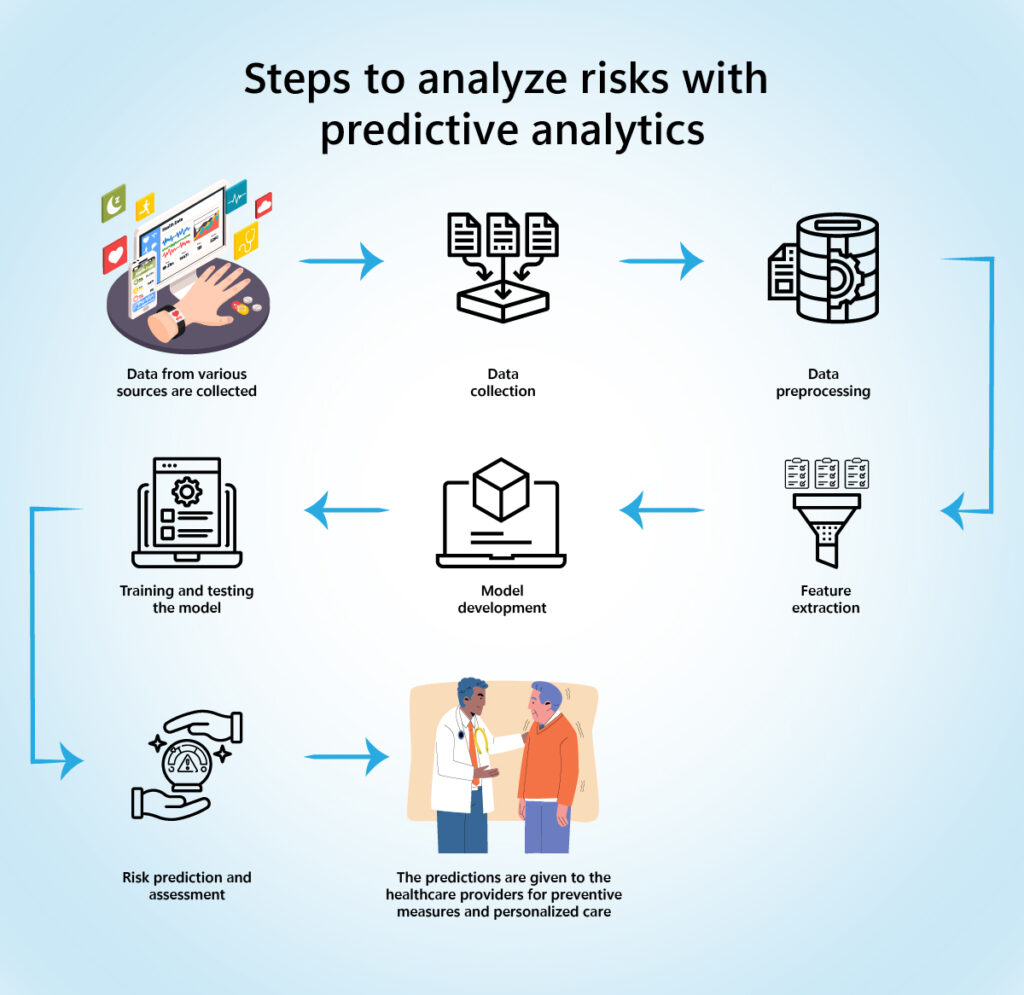Do you know?
As per reports by the World Health Federation (WHF), Geneva, May 2023, deaths from cardiovascular diseases (CVD) skyrocketed to 60% over the last 30 years.
So, aren’t there any solutions to prevent the risks of attacks and strokes?
Prof. Fausto Pinto, former President of WHF, said, “Up to 80% of premature heart attacks and strokes can be prevented. It is vital that countries prioritize rolling out tools and policies to protect people from CVD.”
Enters Predictive Analytics!
But how is predictive analytics leveraged to analyze risks?

There are vast amounts of patient data. This data may be in the form of Electronic Health Records (EHRs), medical imaging, lifestyle data, laboratory results, genetic information, patient demographics, and more. All these data are gathered from various sources.
The data collected must be relevant to analyze the associated risks. For example, to analyze the risks associated with heart attack, you need lab tests like Lipid profile, Troponin blood test, age, Blood pressure, Cardiac CT, ECG, Echocardiogram, heart rate, and many more.
After data collection, preprocess the collected data to ensure its quality and usability. Preprocessing usually includes data cleaning by removing duplicates, handling missing values, correcting errors, and standardizing formats. All this is for making your data suitable for analysis.
Once your data is in a usable format, relevant variables are identified. These variables are the most likely to impact the risk being assessed. This process aims to reduce dimensionality and focus on the most informative variables, which can improve the accuracy and efficiency of the predictive model. Various techniques like statistical tests, correlation analysis, and domain expertise help to select the most relevant features to analyze.
Now you have the variables that can likely impact the risks being assessed. These variables are fed to a predictive model to analyze the risk. The predictive models use algorithms like logistic regression, decision trees, random forests, support vector machines, and neural networks. But the choice of algorithm depends on the data and the specific risk to be analyzed.
The model is fed with two kinds of datasets- Training set and testing set.
Once the algorithm is finalized, the training set is catered for the model to train it to learn the pattern and relationships from the data. And to assess the model performance, whether it is accurately analyzing the patterns, the model is tested by the testing dataset. Cross-validation techniques, such as k-fold cross-validation, can be used to ensure the model’s robustness and generalizability.
Once the model is trained and validated, it is ready for risk prediction and assessment. New patient data is inputted into the model, and the algorithm calculates the probability or risk score associated with the target event, such as a heart attack.
The output provides insights into the likelihood of the risk occurring for everyone. These risks are further communicated to the healthcare professional to make informed decisions such as preventive measures, interventions, personalized care, etc.,
Patients can also be informed about individual risks, empowering them to make lifestyle changes, adhere to medications, and actively participate in their healthcare regime.
Throughout the process, it is vital to regularly monitor and evaluate the predictive model performance, updating it as new data becomes available and refine it to enhance its accuracy and reliability.
Predictive analysis helps uncover hidden patterns and trends within large datasets, enabling healthcare providers to proactively identify and manage risks, leading to better patient outcomes and improved healthcare delivery.
Do you want to unlock the potential of Predictive Analytics to revolutionize patient care?
How are healthcare providers leveraging Predictive Analytics to deliver personalized care and reduce heart attack risks?

Healthcare professionals are delving deep into advanced data analysis to transform patient care, improve outcomes, and save lives. With Predictive Analytics, they can:
Proactively identify high-risk patients:
You can identify patients at-risk by analyzing factors like age, medical history, lifestyle choices, and genetics using Predictive Analytics. It generates risk scores to prioritize those needing immediate attention and interventions for risk reduction.
For example: The American Heart Association (AHA) developed the ASCVD Risk Estimator Plus. This mobile application uses predictive analytics to assess an individual’s risk of atherosclerotic cardiovascular disease (ASCVD), including heart attacks. The app considers factors like cholesterol levels, blood pressure, and smoking status to estimate the likelihood of future cardiovascular events.
Craft patient-centric approaches:
You can craft treatment plans that cater to each patient’s unique risk profile using Predictive Analytics. By analyzing patient-specific factors and leveraging powerful algorithms, interventions can be precisely tailored to address individual risk factors. Say goodbye to one-size-fits-all approaches and embrace personalized care for better outcomes.
For example, the Framingham Risk Score is a well-known predictive model that estimates an individual’s 10-year risk of developing cardiovascular diseases, including heart attacks. This scoring system considers multiple variables like age, gender, blood pressure, cholesterol levels, and smoking habits to provide personalized risk assessments. With this risk score, healthcare professionals can recommend appropriate interventions such as lifestyle modifications, medications, or surgical procedures.
Continuous monitoring and alert systems:
Predictive analytics can be combined with real-time monitoring technologies to create alert systems that notify you about potential heart attack risks. By analyzing patient data in real-time, such as electrocardiograms (ECGs), blood pressure readings, and other vital signs, algorithms can detect anomalies or patterns indicative of an impending heart attack. This enables timely interventions and emergency responses.
For example, the Health e-heart study is a large-scale research initiative that leverages wearable devices and predictive analytics to monitor patients at risk of heart disease. By continuously collecting data on heart rate, activity levels, and sleep patterns, the study aims to identify patterns that may precede a heart attack. In case of anomalies, healthcare providers are alerted, enabling prompt medical interventions.
Briefly, Predictive analytics holds immense potential in reducing heart attack risks by identifying high-risk patients, personalizing treatment strategies, and enabling continuous monitoring.
By leveraging advanced algorithms and vast amounts of patient data, healthcare providers can intervene proactively, preventing heart attacks or mitigating their severity. As this field continues to evolve, predictive analytics applications in cardiovascular care will become increasingly precise and effective, leading to improved patient outcomes and a healthier society.


